The Internet of Things: A technical primer has been saved

The Internet of Things: A technical primer
08 February 2018
The Internet of Things connects people, places, and products and, in so doing, it offers opportunities of value creation and capture for a full panoply of stakeholders. Organizations, however, should be careful in focusing on IoT initiatives that solve real business problems and create real business value―not just connecting stuff for the sake of connecting stuff.
Introduction
Learn More
Subscribe to receive updates on Emerging Technologies
Subscribe to receive Internet of Things content
Today, it seems easy to imagine a world in which a manufacturing enterprise enjoys complete visibility and monitoring of inventory as it enters the factory, gets processed, and leaves the factory floor. Or a world where it is possible to remotely track and optimize production asset effectiveness—through introduction, maintenance, and retirement—and even detect system failures as they occur to maximize uptime. Or still, another world in which products are given sensor capabilities to detect usage patterns and, on that basis, inspire still more products and revenue streams.
It is easy to imagine these and other such worlds because it is in fact the world of smart connectivity within which we live today—thanks to the capabilities offered by the Internet of Things (IoT).
But it wasn’t always so easy or so “obvious.”
In 1991, long before anyone ever used the term “Internet of Things,” Mark Weiser, chief scientist at Xerox, imagined a world of “ubiquitous computing” in which all objects could sense, communicate, analyze, and act with respect to other objects and people.1 But it was only in 1999 that the term “Internet of Things” was coined by Kevin Ashton, a technologist specializing in sensors and radio-frequency identification (RFID) tags.2 Over the years since then, we have witnessed various IoT applications evolve from concept to fruition across the full range of industries and use cases.3
This primer provides an overview of the IoT—its market space, key drivers, underlying challenges, potential solutions, and the business value it creates. The piece is intended to help readers understand at a high level why they should proceed in considering the technology's current and potential business applications and associated benefits and outcomes.
Defining the IoT
There are several definitions of the IoT in technical literature and popular media. Our definition encompasses the key elements as follows:
The IoT is a suite of technologies and applications that equip devices and locations to generate all kinds of information—and to connect those devices and locations for instant data analysis and, ideally, “smart” action. Conceptually, the IoT implies physical objects being able to utilize the Internet backbone to communicate data about their condition, position, or other attributes.4
Creating and capturing value
The IoT focuses on the aggregation and use of information from several sources. Information, however, creates value only when it is utilized for modifying future action in beneficial ways. Ideally, this modified action gives rise to new information, allowing the learning process to continue. Information, then, can create value not in a linear value chain of process steps but, rather, in a never-ending process. One way of capturing this process is as an Information Value Cycle (IVC) with discrete but connected stages (figure 1).
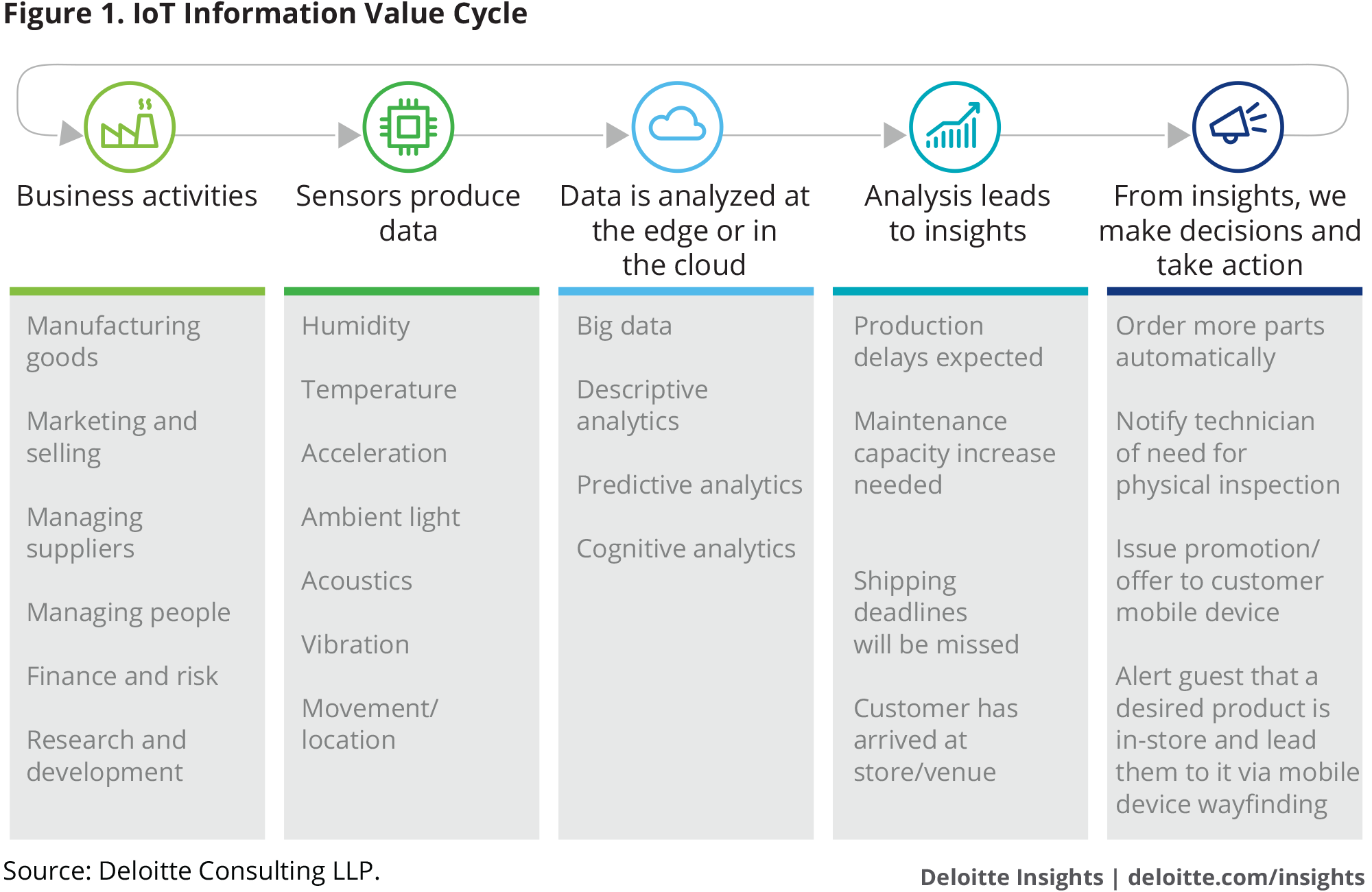
For information to complete the cycle and create value, it passes through the cycle’s stages, each enabled by specific technologies.5 It starts with everyday business activities that generate data. This data is captured by sensors (attached to devices), creating information as a result, along an array of dimensions from vibration to humidity to movement, and beyond. Such information is communicated via a network, aggregated, and analyzed, leading to insights. These insights—sometimes called “augmented intelligence”—may then either enable automated action or shape human decisions (“augmented behavior”) in a manner leading to improved, more competitive business operations, thereby completing the cycle.6
Characterizing the IoT market structure
When one thinks at a very high level, IoT market segments can be generally divided into three broad categories: enterprise/industrial, consumer, and services/public sector. Each of these segments is marked by distinct characteristics and market opportunities (table 1).
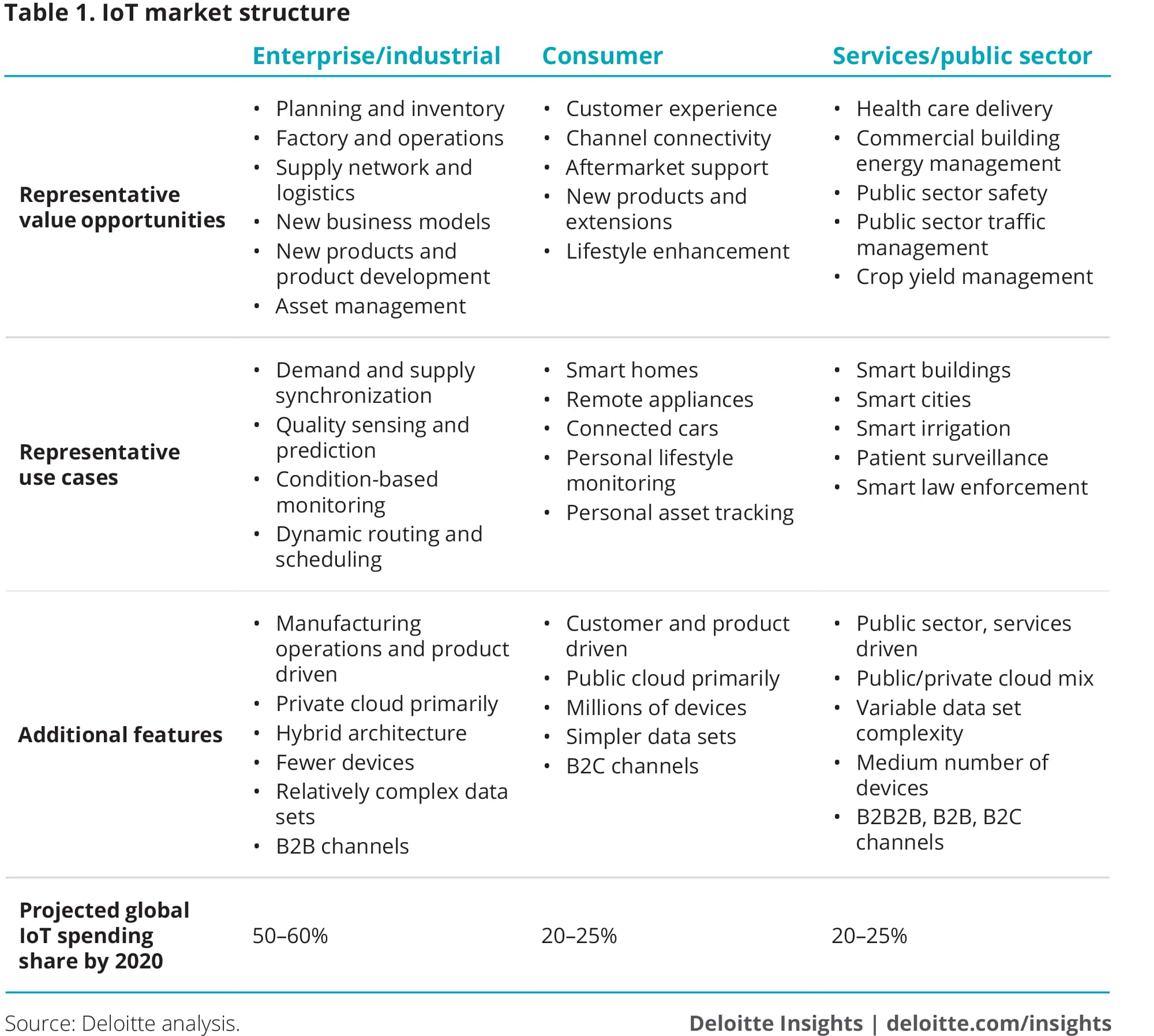
The enterprise/industrial segment involves relatively complex and rich data sets and far fewer devices relative to the consumer segment. The enterprise/industrial segment tends to also be driven by manufacturing operations and product development within a relatively private cloud environment. In contrast, the consumer segment is typically rooted in customer experience and a more public cloud environment. The services/public sector segment is generally something of a hybrid between the other two segments in terms of richness and complexity of data, number of devices, and a bias toward a particular cloud environment, although it tends to bear a closer resemblance to the consumer segment in terms of experience-driven use cases.
The fastest growing IoT segment appears to be enterprise/industrial, projected to capture slightly more than half of global IoT spending by 2020. A particularly strong driver of growth in IoT spending within the enterprise/industrial segment is digital supply network (DSN) applications. While there is a host of DSN use cases that is driving IoT spending within the enterprise/industrial segment, four seem to stand out in particular:
- Condition-based monitoring/predictive maintenance: Monitoring and continuously evaluating key performance parameters of capital assets and, in the process, leveraging advanced analytics to predict failures before they occur
- Asset tracking: Tracking location and movement of assets and/or materials using location-based sensors, enabling real-time reporting and optimization of system performance
- Dynamic routing and scheduling: Enhancing the productivity of both individual units and broad networks using deep and broad insights derived from aspects such as visibility on conditions and performance in real time
- Asset and process optimization: Evaluating and monitoring operational data and ambient conditions of critical assets and processes in real time to optimize performance and safety
Manufacturing is a substantial driver of spending within the enterprise/industrial IoT space as well as overall IoT spending.7 This may be attributed to Industry 4.0 and the ensuing wave of digital transformations that will likely drive significant demand for IoT capabilities across a broad spectrum of services within manufacturing. Other key sectors driving enterprise/industrial IoT include oil & gas, power & utilities, life sciences/health care, and transportation.
Quantifying the IoT market potential
The IoT is a complex ecosystem—there are different approaches to its market sizing. One of the common ways of describing the market is in terms of connected devices. In 2016, the number of IoT-connected devices was estimated at 18 billion units and is expected to grow at approximately 15 percent CAGR to reach about 31 billion units by 2020.8 Other estimates place the projected number of connected devices at somewhat less than this figure.
Alternatively and without regard to the end-use segment, the IoT market can be characterized in terms of four categories of products―device hardware, systems integration, network connectivity, and platforms/applications/cloud solutions.9 These four categories taken together (which comprise the global IoT market) had an estimated market value of $0.4 trillion in 2015, and is forecasted to expand at approximately 20 percent CAGR to reach around $1.1 trillion by 2020 (figure 2).10 As mentioned, the enterprise/industrial sector is expected to account for by far the largest share of this global IoT market by 2020 at about 50–60 percent of total spending.11
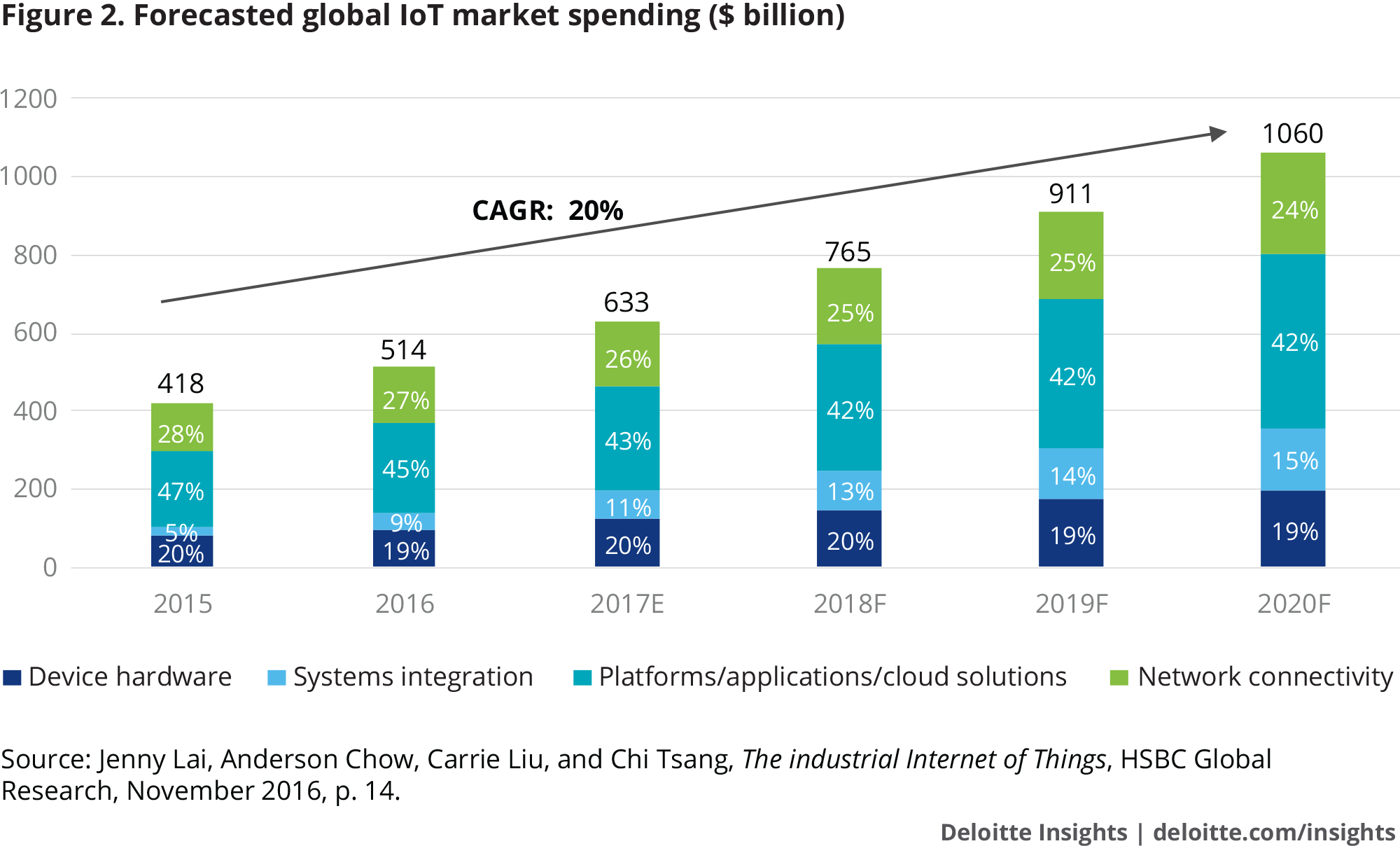
We briefly describe the four product categories below:
- Device hardware: Components used in machines and devices such as sensors and circuits to collect information
- Systems integration: Hardware and software to integrate different proprietary systems with each other and with open systems in order to increase interoperability
- Network connectivity: A host of established network technologies (such as Wi-Fi and Bluetooth) and emerging technologies (such as 5G and Low-Power, Wide-Area [LPWA]) for connectivity among different IoT devices12
- Platforms/applications/cloud solutions: Software solutions to facilitate integration of the other three elements in order to provide a secure user interface and drive on-ground applications; includes data aggregation, visualization, and security; analytics; and action management
Among these four major categories, platforms/applications/cloud solutions account for the largest share (40–45 percent over the forecast period). However, the fastest growing segment is systems integration, which is expected to grow at 52 percent CAGR from 2015 to 2020, tripling its share of global IoT spending from 5 percent to 15 percent.13
Enabling technologies and industry undercurrents driving the IoT despite some impediments
The growth of the IoT over the last few years can be attributed to a number of beneficial factors, some of which are discussed below:
- Bandwidth, data storage, and computing prices declining: Costs associated with transferring, storing, and analyzing data have declined precipitously over the last two decades (figure 3).14
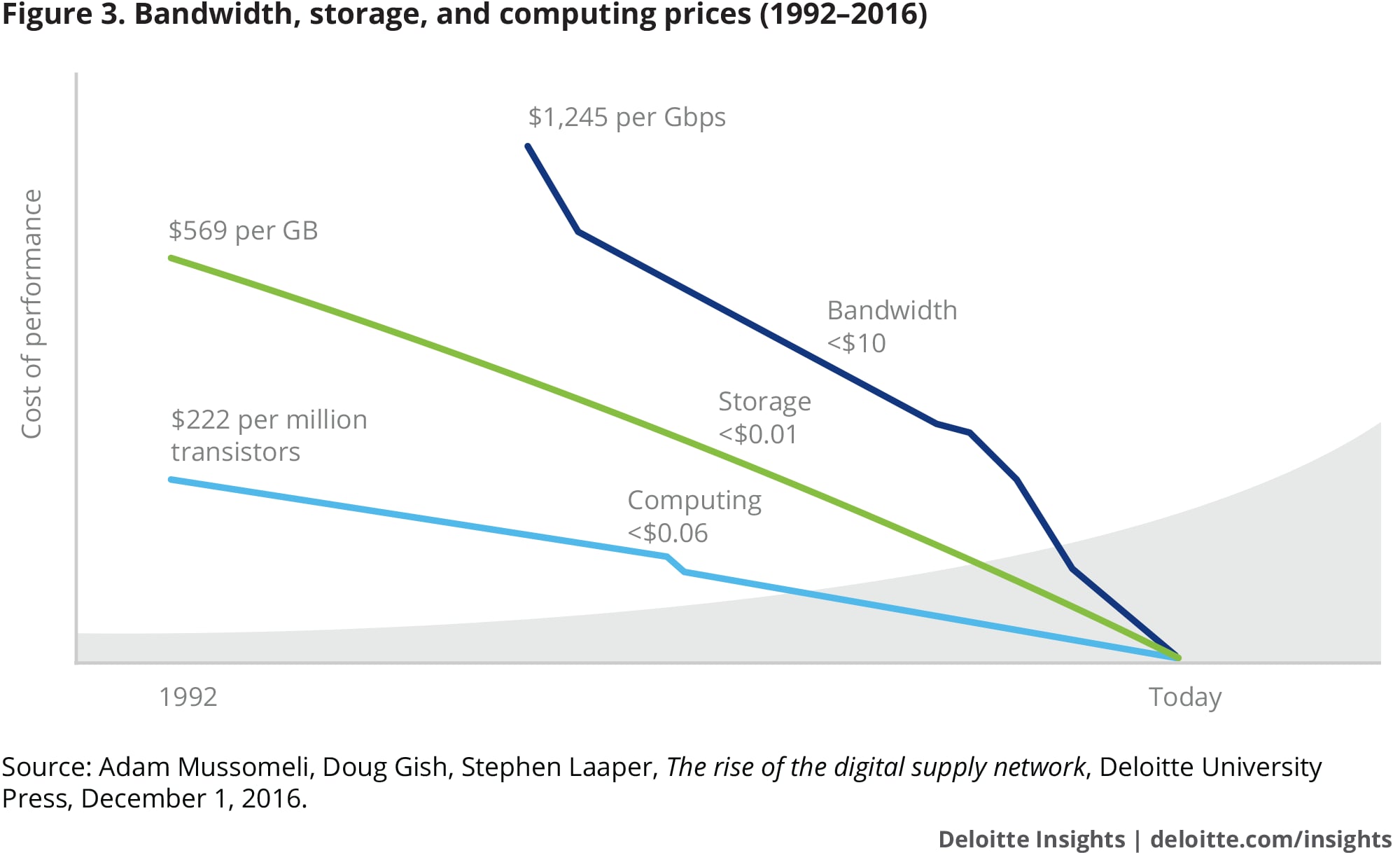
- Growing analytics applications driving the use of augmented intelligence: IoT applications are increasingly driven by both decreasing storage costs (figure 3) and volumes of big data (figures 4)—coupled with growth in advanced analytics tools, proprietary as well as open-source, such as the R package (figure 5). We are witnessing applications of augmented intelligence for not just analyzing past business performance but also making predictions about customer demand, supply chain optimization, machine performance, etc.15
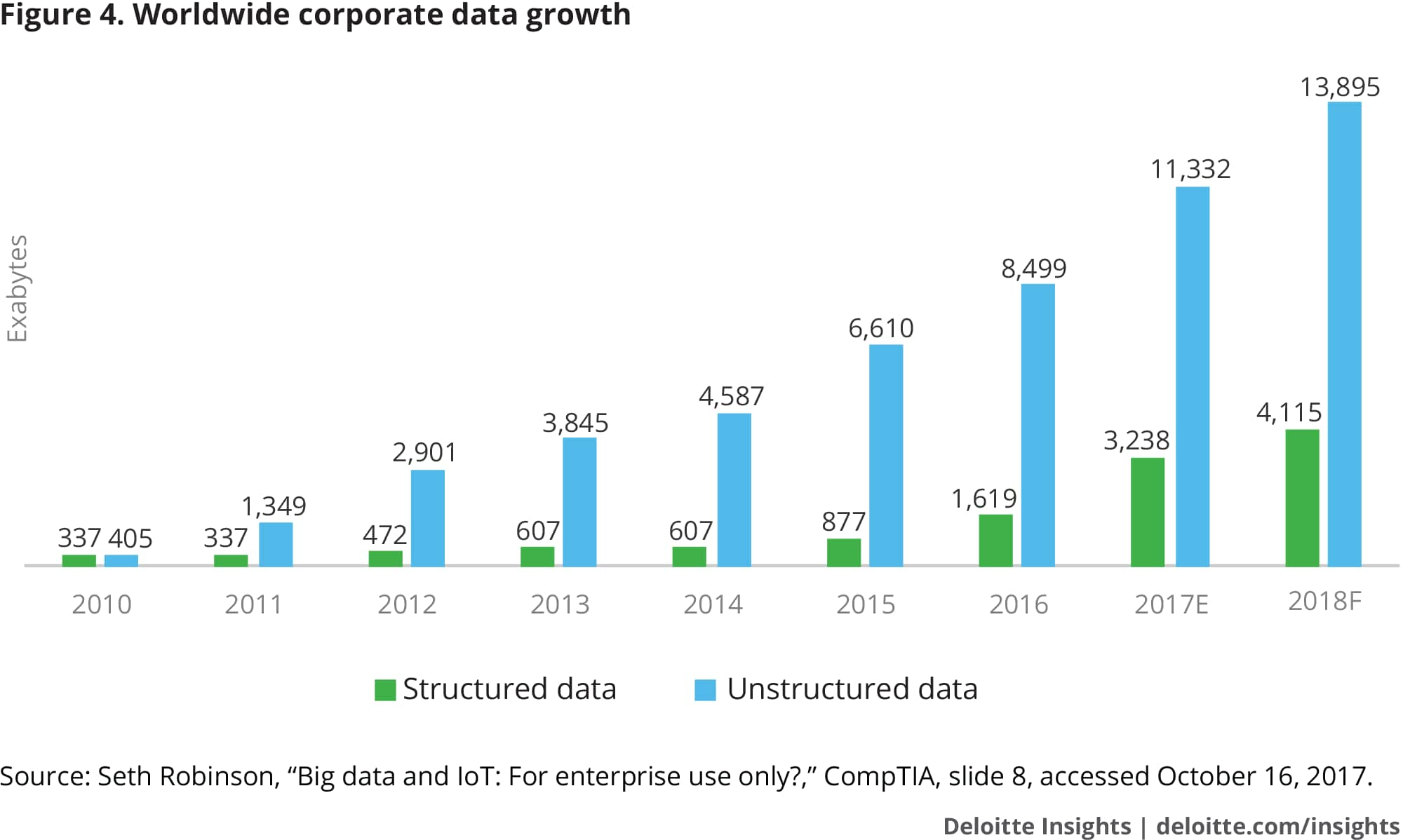
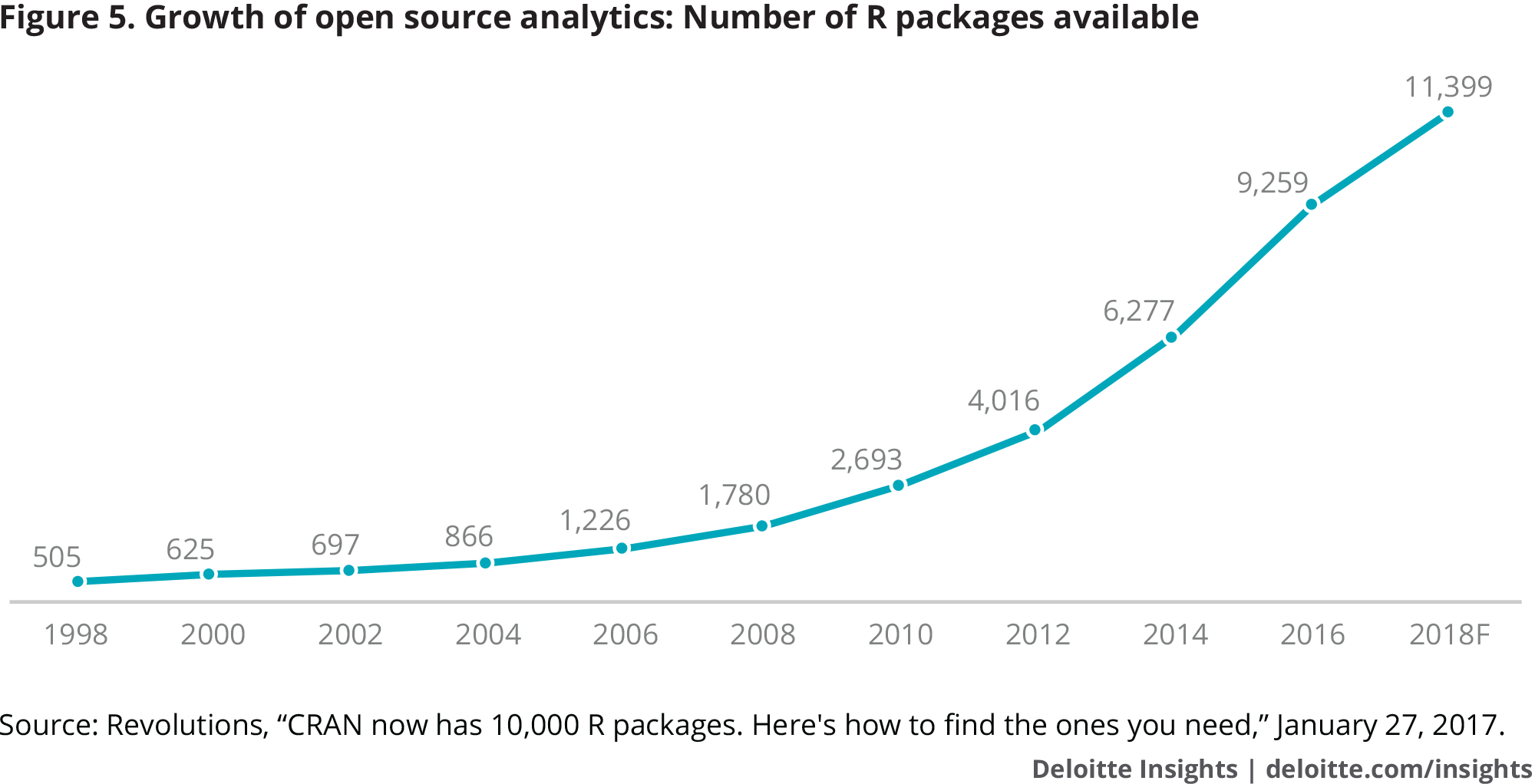
- Expanding use of augmented behavior from simple automation to complex decision-making: Improved functionality at lower prices (figure 6) is driving higher penetration of industrial robots (figure 7). For situations where a user needs to take the action, machines are increasingly being developed with basic behavioral science principles in mind, allowing them to influence human behaviors in positive and effective ways.16
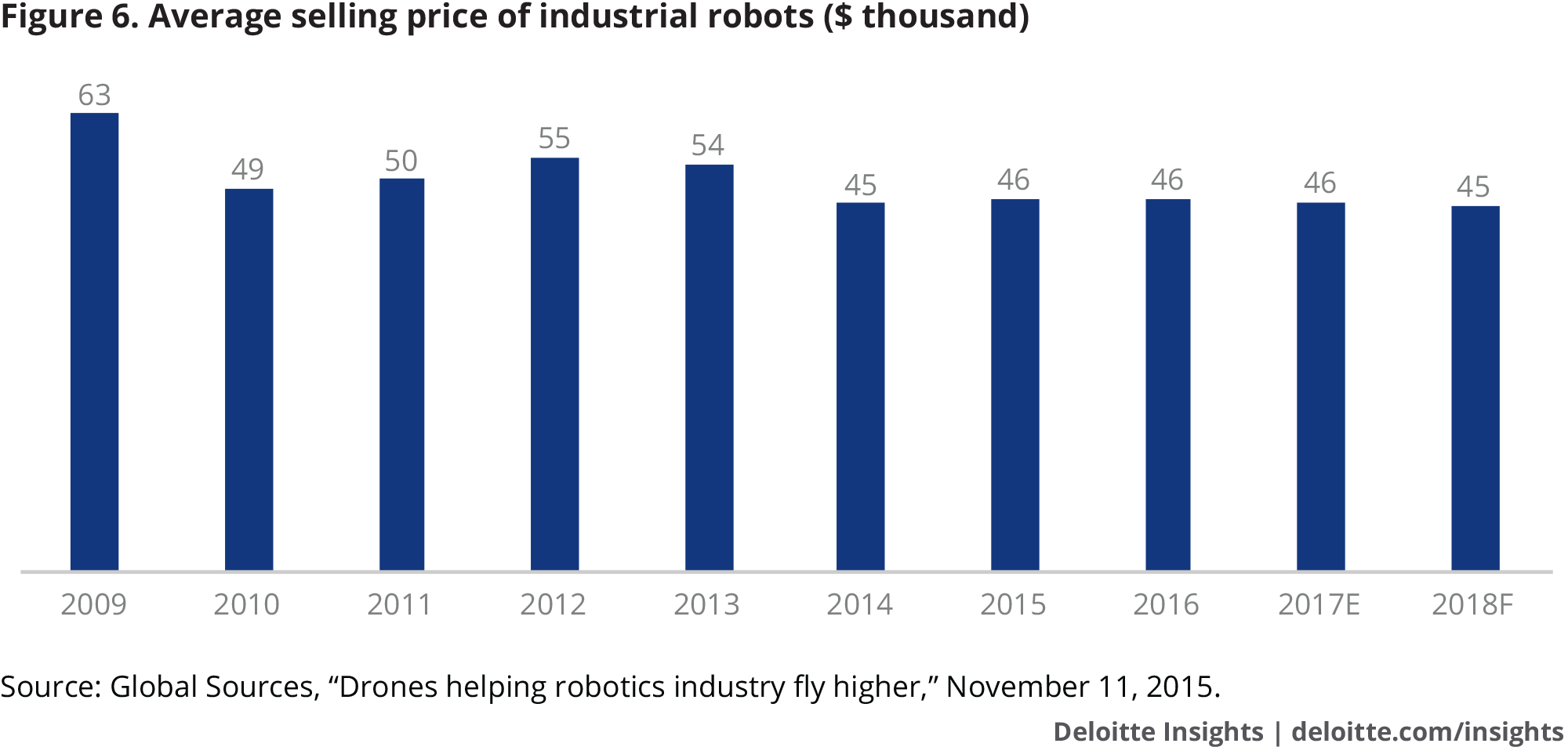
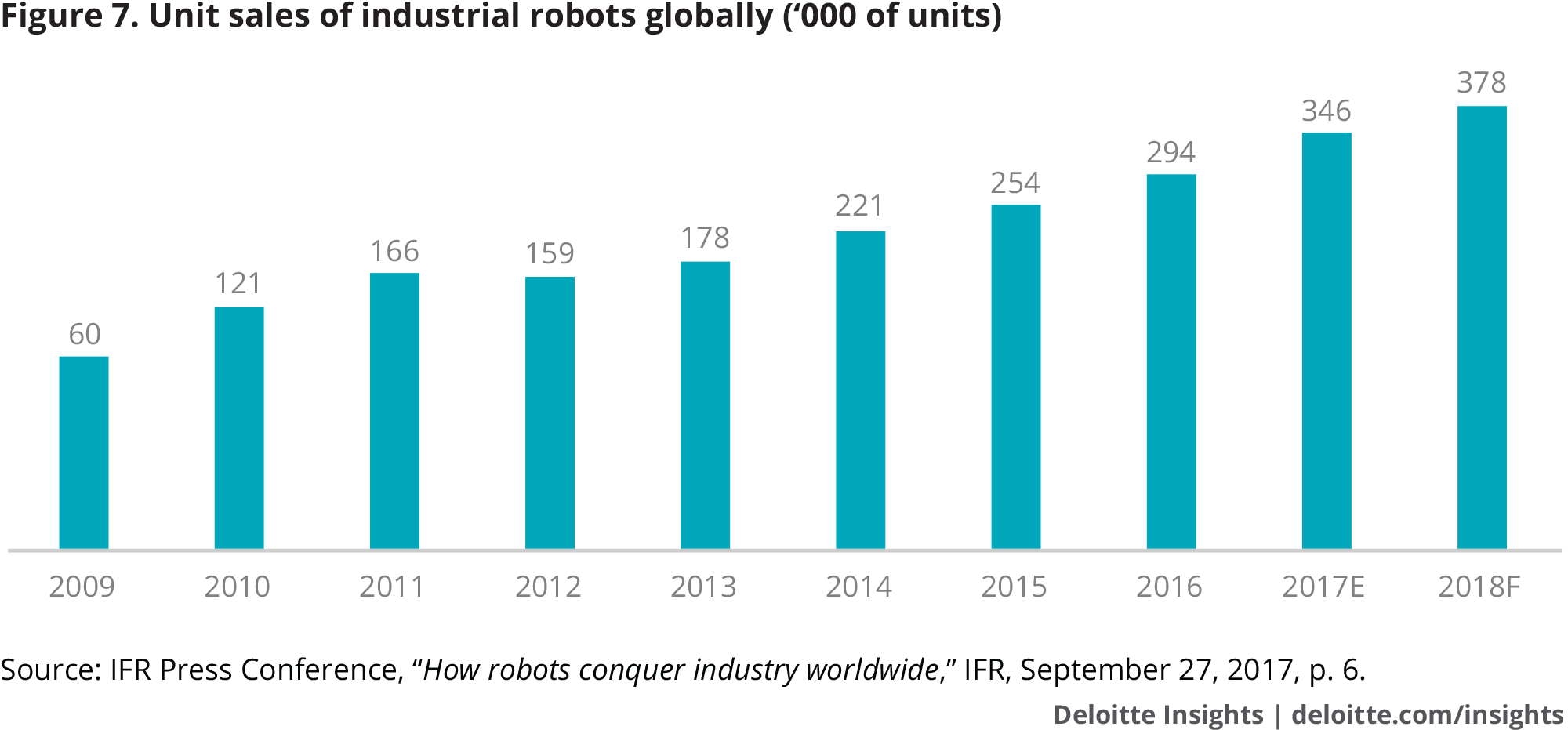
- Sector-specific undercurrents also driving demand: Beyond industry-agnostic technical drivers of the IoT reside sector-specific demand conditions. In manufacturing, for example, a broad digital transformation seems to be taking place under the banner of Industry 4.0 that undergirds the deployment of advanced analytics IoT capabilities. Within the power and utilities sector, a desire to “reach beyond the meter” in optimizing network performance, among other factors, appears to be driving IoT investments. The call for integrated smart city initiatives is likely driving public sector IoT spending. The explosion of health-related data and unyielding demand for health care delivery options “anytime, anywhere” seem to be driving IoT solutions within life sciences and health care. Other examples of sector-specific IoT demand drivers abound.
While we discussed above some key factors that seem to be driving the growth of the IoT, we should be mindful of some of the issues hindering IoT applications, and their corresponding potential solutions. Table 2 offers a set of some of the technical challenges that confront continued IoT development.
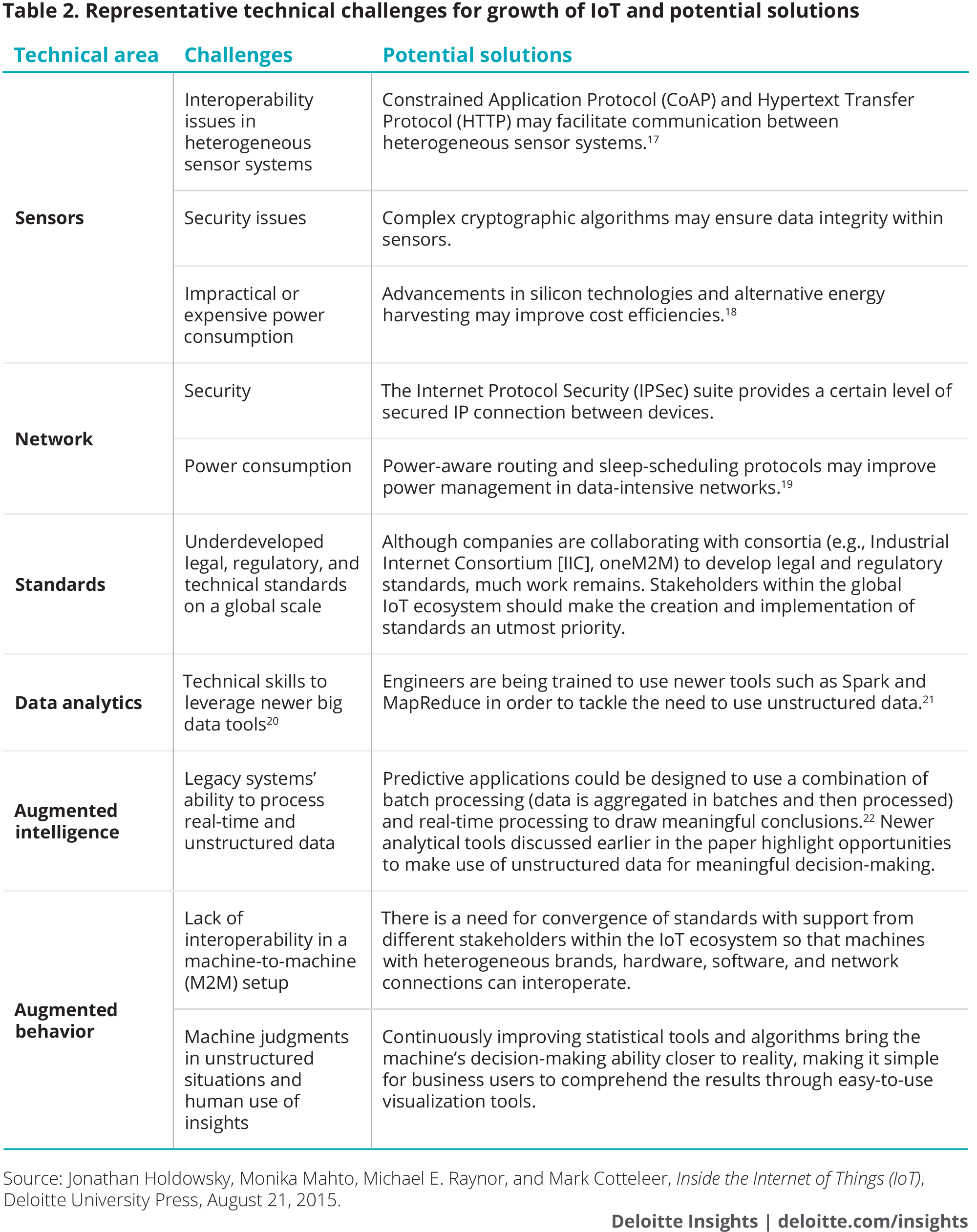
Beyond the scope of these technical challenges seem to reside some very real challenges of cultural resistance to the adoption of the smart solutions that IoT offers. Some of this resistance stems from the workforce itself, perhaps slow in accepting a “new way of doing things.” Some of this resistance seems to also stem from a reluctance on the part of organizations that don’t yet understand or are otherwise unable to articulate the IoT value proposition. And, still others believe in the IoT value proposition, but misapply it in ways that merely pursue connectivity for its own sake, without a real plan to address real business problems. We will speak more on this shortly.
Exploring a range of IoT applications
The IoT is transforming business models, given its applicability for a wide range of applications in different industries and geographies. A sampling of the current and emerging IoT-related applications is described in table 3 by industry.

Key considerations for organizations
The IoT is emerging as an important digital transformation technology irrespective of the industry, business function, or geography. Costs associated with data collection, transfer, processing, storage, and computing have together come down to a point where they can drive significant mainstream IoT applications. With fast-evolving and expanding applications, the IoT seems to be shaping into an increasingly complex ecosystem that offers opportunities of value creation and capture for different stakeholders, including individuals, societies, companies, consortia, and governments. As such, the IoT is increasingly influencing the way we run businesses and live our lives. Additionally, the IoT is also expected to drive and support a number of related yet different technologies such as augmented/virtual reality, automation, and robotics.
All of this said, however, organizations should bear in mind that “connectivity” in and of itself is not a strategy that necessarily provides real business value. Unfortunately, many IoT initiatives end up being “shiny” solutions in search of a problem, concepts that have popular appeal but don’t deliver real-world value. And organizations should be focusing on IoT initiatives that create real business value―not just connecting stuff for the sake of connecting stuff.
Indeed, the real power of the IoT likely resides in harnessing its incredible potential in solving real problems and, in so doing, creating real business value. From asset monitoring and predictive maintenance to fleet management and logistics to smart supply chains to smart mobility and well beyond, the IoT—when used strategically—can help solve some of the most nettlesome challenges that organizations of all kinds face today. As IoT applications are evolving with each passing day, companies may wish to think through their current and future strategic positioning and build product and service offerings accordingly.
And toward that end, companies can adopt a commonsense approach in implementing IoT solutions successfully. First, companies should think big. Push the envelope in developing an ambitious and forward-looking IoT vision that cuts across organizational silos. Second, companies should actually start small. Target the most promising opportunity areas, launch small and swiftly, and go for the rapid wins. Third, companies should scale fast. Once an IoT initiative is proven successful, companies should scale up quickly to maximize benefits. Finally, companies should consider turnkey solutions that may help to jump-start the process—solutions that are geared toward a particular industry or business application in line with the organization’s objectives.
There is no magic formula when it comes to successful IoT implementation. But companies that know what they want to achieve in relying on the IoT—and approach it with a vision that is grounded in real-world issues—may very well have a leg up in achieving strategic objectives.
Final thoughts
The next few years will likely be marked with increasing applications of the IoT in different industries. In developing this primer, our objective was to help organizations review the market potential and assess current and potential applications, think through different opportunities for value creation and capture, and address key challenges to adoption. Additionally, as the IoT supports different technologies such as robotics, augmented reality, and automation, this primer should serve as reference material for several other technologies that we will discuss in individual primers.
For more information, including IoT-related industry perspective and use cases, please refer to the Internet of Things collections page on Deloitte Insights.
© 2021. See Terms of Use for more information.
